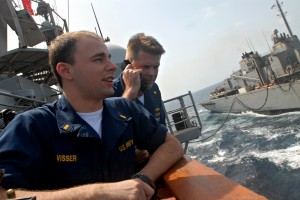
… this one of me and my boss LT Molmer, the Combat Systems Officer. I’m conning the ship alongside an oiler and he’s serving as the conn coach… I’m laughing because the phone he’s on is normally inside and was carried outside with its cord out behind it so he could answer. The picture was actually taken by a Navy Times reporter.
“Conn,” meaning the power to metaphorically steer the course of an endeavor or enterprise, comes from the literal use of that power. When “conn” (in the form “cun”) first appeared in English in the 17th century as a verb, it meant “to direct the steering or course of a ship,” usually from the bridge of the ship or its equivalent. Obviously, the captain of a ship has the primary responsibility for “conning” the vessel, but often delegates the “conn” (the noun appeared in the early 19th century) to subordinate officers. Early battleships actually had elevated “conning towers,” armored to protect the captain, et al., but today the same functions are usually carried out from a “conning station” on the ship’s bridge.
For a term redolent of the high seas and naval battles of yore, “conn” has a remarkably tame origin. “Conn” apparently arose as a variant form of the verb “cond,” also meaning “to direct the steering of a ship,” which in turn derived from the obsolete verb “condue,” meaning “to conduct or guide.” As you might suspect, “condue” itself ultimately harks back to the Latin “conducere” (to lead or guide), which also gave us our modern English “conduct.”